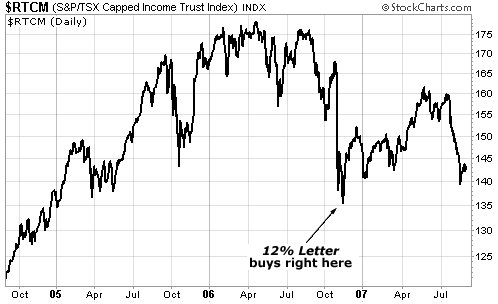| Home | About Us | Resources | Archive | Free Reports | Market Window |
Why Investors Hate Canada's Natural Gas StocksBy
Friday, August 31, 2007
On October 31, 2006, the Canadian finance minister announced a plan to phase out, after 2011, the tax benefits enjoyed by Canadian income trusts. It was one of the biggest financial dislocations of the year. At the time, I figured investors had overreacted. For a start, the policy wouldn't take effect until 2011, so dividends would continue as normal for another four years. Besides, with the 15% drop in the income trust index, I figured investors had already priced in the worst-case scenario for income trusts, so downside was limited. Besides, four years is a long time in politics. I anticipated the government might amend the law or scrap it altogether. A few days after the announcement, I recommended 12% Letter readers buy Enerplus Resources, Penn West Energy, and Provident Energy – three of the largest, best-quality oil and gas income trusts in Canada. Right now, they yield an average of 12.5%. Looking back, we timed our buy perfectly...
Now look at the chart again. See how the income trust sector has taken another dive this month? That's fear associated with the credit crunch in the United States. Despite this recent fall, we're up an average 20% in these companies, with 10% coming in dividends. I think we have even more gains to come. Ten months have passed since the Halloween trust shocker. In today's column, I want to tell you about another fantastic opportunity to emerge from this carnage: Canadian natural gas income trusts. The Canadian natural gas market is extremely cyclical. In this market, you're either a contrarian or a victim. Right now in the Canadian natural gas market, fear and pessimism reign, the lingering result of the 2005 burst of an investment bubble. In 2005, natural gas prices rocketed to $15 per thousand cubic feet (mcf) - an astronomical rise. That led to a flood of investment in natural gas projects. By early 2006, the price of natural gas declined, undercutting many of those projects. But the investment boom of the previous year left so much infrastructure in the field, it seemed Canada would never need another oil company, gas well, or pumping station again. Then, add in the effect of the Halloween trust legislation and a stretch of favorable weather conditions in North America, and you have the worst possible conditions for the Canadian natural gas sector. Roger Conrad, editor of Canadian Edge, a newsletter that covers exclusively Canadian income trusts, said this last week: It's difficult to imagine the Canadian natural gas drilling market getting much worse. But at this point, though not quite the mind-bender the first exercise is, it's tough to see the recovery, too. Many of the natural gas companies I follow in Canada are down more than 50% since the bubble burst in January 2006. Even the huge natural gas income trusts – with billion-dollar market caps – are down more than 40%. It's my thesis that these cheap natural gas companies will be expensive again. Athabasca is my reason. The oil companies in Athabasca simply cannot manufacture oil without natural gas. Natural gas powers their plants and refineries. It's also used to generate steam. Steam is used to separate sand from oil. As the oil companies in Athabasca ramp up production of oil by 300% over the next decade, they're going to need huge quantities of natural gas. Gas is hard to transport. So Canada's natural gas – located mostly in Alberta near the oil sand developments – will look very attractive. I think the oil-sand executives are aware of this problem, but right now, they're happy to ignore it. The pressure of dealing with Wall Street makes managers of publicly traded companies very shortsighted. Long term for Wall Street is next quarter. The truth is, right now – and into the near future – the market has plenty of natural gas. So the oil company guys think, "Well, it might be a problem in the future, but for now we're OK, so let's not worry about it." I can understand the oil companies not wanting to spend capital on nonessential projects. They have Wall Street breathing down their necks for quarterly results. They need to save their money for projects that generate immediate results. But at least, I would have expected investors to learn their lesson... Fortunately, that never happens, because if it did, all financial markets would stop working. But that's a story for another time... Today, we simply have to thank the investors who've panicked and sold their assets on the cheap. They don't know that when things get worse, they can only get better. We know things will get better... and we'll collect double-digit dividends while we wait. Good investing, Tom
Market NotesDR. COPPER MAY BE CATCHING A COLD
Only a fool ignores the world's greatest economist, Dr. Copper. Due to copper's widespread use in electrical transmission, household appliances, cars, and piping, its price reflects construction activity and the demand for industrial products. This sensitivity gives copper a Ph.D. in economics with its ability to send messages about the world's economic health. For the past several years, we've scoffed at analysts predicting a global economic slowdown... citing the soaring prices of engine maker Cummins, construction aggregate producer Martin Marietta, and copper as "real world" indicators of economic health. We're far from chartists at DailyWealth... but we've noticed Dr. Copper has twice made a run at its 2006 high of $4 per pound, and twice has failed. If we're truly in for a recession, the good doctor will continue to head lower. In addition to the supply situation we described last month, we're keeping an eye on this bearish chart.
|
Recent Articles
|


